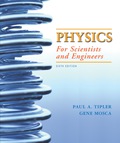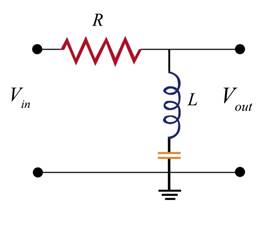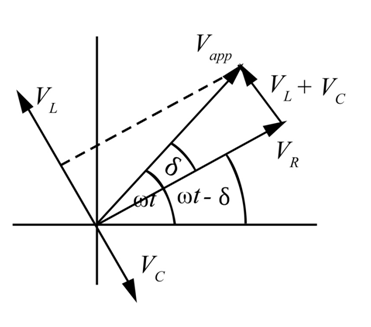
(a)
ToShow:
The trap filter acts to reject signals in a band of frequencies centered
(a)
Answer to Problem 55P
The trap filter acts to reject signals in a band of frequencies centered at
Explanation of Solution
Given:
The given diagram is shown below

The above circuit is a trap filter circuit. Its phasors diagram is shown below.
Calculation:
The phasor diagram for the trap filter is shown below.

Here
The projection of
Define bandwidth as
Here,
And
Output voltage
Here,
And
Now,
Substitute
Again substitute
Now,
Substitute 0 for
Conclusion:
Hence, it is shown that the trap filter acts to reject signals in a band of frequencies centered at
(b)
The way, the width of the frequency band rejected depends on the resistance
(b)
Answer to Problem 55P
The width of the frequency band rejected is directly proportional to the resistance.
Explanation of Solution
Given:
The given circuit diagram is shown below

The given circuit is a trap filter circuit. Its phasors diagram is shown below.
Calculation:
The required Phasor diagram is shown below

Here
The projection of
Define bandwidth as
And impedance of the trap as
These two will yield an expression for the bandwidth and reveal its dependence on R.
Substitute
Again,
Substitute
For
For the case,
Substitute
Conclusion:
Hence, the width of the frequency band rejected directly proportional to the resistance.
Want to see more full solutions like this?
Chapter 29 Solutions
Physics for Scientists and Engineers
- In the following figure the circuit to the left has a switch thatat t = 0 s is switched and disconnects the battery from the circuit. The state depicted on thefigure is right after the switch, still t = 0. As the current decreases over time, the magneticflux through the circuit on the right (due to the long cable of the circuit on the left) changesand induces an EMF on the right circuit. How much power is consumed by R2 as a functionof time.The distance between the wire on the left and the closest wire on the right is r = 2.0 cm.The size of the circuit on the right is noted on the figure.arrow_forwardsingly A samply ionized helium atom is in the ground state. It absorbs energy and makes a transition to the n=7 excited state. The ion returns to wo the wavelength the ground state by emitting SIX photons ONLY. What is the of the second highest energy photon ?arrow_forwardAn electron, traveling at a speed of 5.60x10° m/s, strikes the target of an X-ray tube. Upon impart, the eletion decelerates to one-third of it's original speed, with an X-ray photon being emitted in the process. What is the wavelength of the photon? m.arrow_forward
- Can you help me solve this 2 question and teach me what we use to solve thisarrow_forwardYou are working during the summer at a company that builds theme parks. The company is designing an electromagnetic propulsion system for a new roller coaster. A model of a substructure of the device appears in the figure below. Two parallel, horizontal rails extend from left to right, with one rail behind the other. A cylindrical rod rests on top of and perpendicular to the rails at their left ends. The distance between the rails is d and the length of the rails is L. The magnetic field vector B points vertically down, perpendicular to the rails. Within the rod, the current I flows out of the page, from the rail in the back toward the rail in the front. The rod is of length d = 1.00 m and mass m = 0.700 kg. The rod carries a current I = 100 A in the direction shown and rolls along the rails of length L = 20.0 m without slipping. The entire system of rod and rails is immersed in a uniform downward-directed magnetic field with magnitude B = 2.30 T. The electromagnetic force on the rod…arrow_forwardBased on the graph, explain how centripetal force is affected when the hanging mass changes. Does your graph verify the relationship in the equation r = x^i + y^j = r cos ωt I + r sin ωt^j?arrow_forward
- Can you help me to solve this two questions can you teach me step by step how to solve it.arrow_forwardGiven: ruler 11.56 g, small washer 1.85 g each, large washer 24.30g each Use the data in Data Tables 4 and 5 to experimentally determine the mass of your ruler. Use one of your 2 trials with 1 small washer at 0 cm, one of your 2 trials with 2 small washers at 0 cm, and one of your 2 trials with 3 small washers at 0 cm to find three experimental values for the mass of the ruler. How do you experimentalls determine the mass?arrow_forwardCompare the 3 experimental masses of your ruler to the measured mass of your ruler (Data Table 1) by calculating the percent error for each experimental value. Which trial provided the best data for determining the mass of the ruler? Please help, I am not sure how to calculate this. Thanks!arrow_forward
- Please help, everytime I try to input the data only one point shows on the graph. Please graph unsing centripetal force, Fc, versus V E2 from Activity 1. Include a line of best fit and record the equation of the line. Thank you!arrow_forwardPlease help, everytime I try to input the data only one point shows on the graph. Graph of centripetal force, Fc, versus V E2 from Activity 1. Include a line of best fit and record the equation of the line.arrow_forwardBased on your graph, explain how centripetal force is affected when the hanging mass changes. Does your graph verify the relationship in the equation r = x^i + y^j = r cos ωt I + r sin ωt^j?arrow_forward


 Glencoe Physics: Principles and Problems, Student...PhysicsISBN:9780078807213Author:Paul W. ZitzewitzPublisher:Glencoe/McGraw-Hill
Glencoe Physics: Principles and Problems, Student...PhysicsISBN:9780078807213Author:Paul W. ZitzewitzPublisher:Glencoe/McGraw-Hill Classical Dynamics of Particles and SystemsPhysicsISBN:9780534408961Author:Stephen T. Thornton, Jerry B. MarionPublisher:Cengage Learning
Classical Dynamics of Particles and SystemsPhysicsISBN:9780534408961Author:Stephen T. Thornton, Jerry B. MarionPublisher:Cengage Learning Physics for Scientists and Engineers: Foundations...PhysicsISBN:9781133939146Author:Katz, Debora M.Publisher:Cengage Learning
Physics for Scientists and Engineers: Foundations...PhysicsISBN:9781133939146Author:Katz, Debora M.Publisher:Cengage Learning College PhysicsPhysicsISBN:9781938168000Author:Paul Peter Urone, Roger HinrichsPublisher:OpenStax College
College PhysicsPhysicsISBN:9781938168000Author:Paul Peter Urone, Roger HinrichsPublisher:OpenStax College





